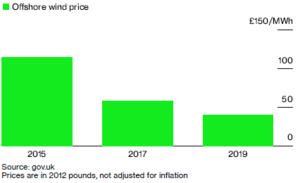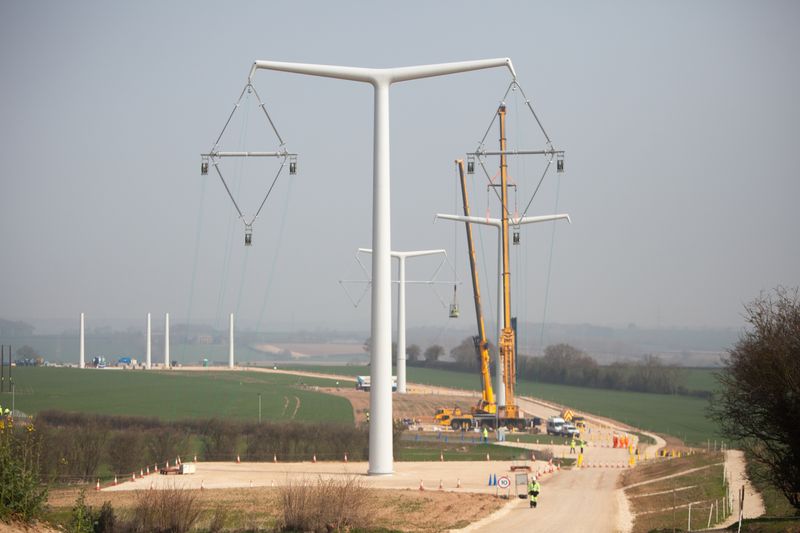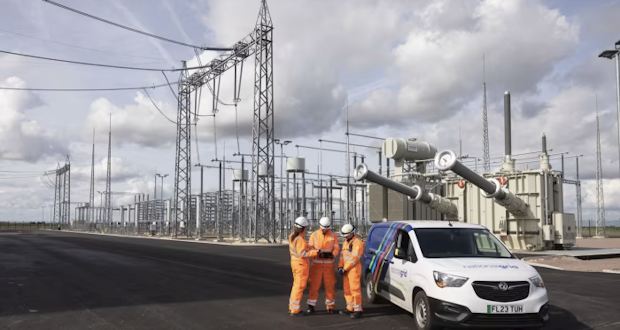Britain’s electricity grid operator is pushing deeper into the turbulent waters of the North Sea, seeking to support the government’s $27 billion program to build up the offshore wind industry.
Executives from National Grid Plc meet government officials on Thursday to discuss how a growing tangle of projects offshore can be best connected to the network on land. At the moment, wind farms at sea are each linked individually with separate cables. Combining some of those links could cut the amount of new infrastructure needed in half.
The work is crucial for Prime Minister Boris Johnson’s government to deliver on commitments to eliminate fossil fuel emissions by 2050. Ministers put offshore wind at the heart of plans to cut carbon emissions from power generation, and the current system of grid connections would leave an expensive and unmanageable tangle of wires reaching from wind farms at sea to the shore.
“The existing process of linking single offshore wind farms is a legacy regime which needs updating,” said Barnaby Wharton, RenewableUK’s Director of Future Electricity Systems. “We need to ensure we land on a solution which is technically feasible and cost-effective.”
Surge at Sea
A growing number of offshore wind farms need to connect to the grid.
Britain is among the first nations to build a substantial offshore wind industry, so the solutions it finds are likely to influence others. The government started a review into the offshore transmission network in July and is hearing from National Grid as part of that.
With the capacity set to quadruple within nine years, a design needs to be drawn up quickly. Costs of wind farms at sea have fallen dramatically in recent years, mostly because of lower financing and turbine prices. The cost of transmission represents the industry’s next big opportunity to make itself more economical.
Pairing multi-purpose interconnectors with wind capacity could bring a 50% reduction in how much grid infrastructure needs to be built in the next three decades, saving consumers 6 billion pounds ($8 billion) by 2050, according to National Grid.
Price Plummet
The price for offshore wind has fallen rapidly in U.K. government auctions.  One example already underway is a power cable between the U.K. and Dutch power transmission operator Tennet Holding BV to link as much as 4 gigawatts of wind farms in both countries.
One example already underway is a power cable between the U.K. and Dutch power transmission operator Tennet Holding BV to link as much as 4 gigawatts of wind farms in both countries.
“There’s a real benefit both in terms of cost to those coastal communities, and the environment in terms of less disruption, by taking a much more coordinated approach,” said Alice Etheridge, senior manager for offshore coordination at National Grid, the part of the company in charge of designing the system. The work, she said, is about “bringing those connections together, seeing whether it can be clustered offshore, and then where you can cluster if you can bring that electricity to land, closer to where it’s needed.”
The U.K. wants to increase interconnector capacity threefold to 18 gigawatts by 2030 and will give the nation the potential to be a net exporter of excess wind power.
Popular Resistance
Once the connection to land is made the real difficulty starts, according to Nicola Shaw, executive director for U.K. at National Grid. Where possible the company tries to take cables offshore and out of sight, but that’s more expensive.
Offshore wind has relieved some of the public outcry over the view and noise from spinning blades. That’s because they’re built so far out to sea that the massive turbines aren’t even visible from the shore.
But local residents have shifted their ire on transmission. New capacity means either a new overhead line, or digging up the ground and placing the cable in a channel.
“Many of us may not be aware of the massive scale of industrialization that will come along with each offshore wind farm,” an organization of residents in the east of England called Suffolk Energy Action Solutions says on its website. “We say, ‘Yes To Offshore Wind Energy but Let’s Do It Right.”’
The group wants the government to deny a planning application by Iberdrola SA to build 1.7 gigawatts of offshore wind. They say that there are other, less intrusive ways the projects could be built.
“It’s much cheaper to do the overhead line, but it isn’t always what the local population would want,” Shaw said. “There’s a balance to be struck.”
Original article: https://www.bloomberg.com/news/articles/2020-12-17/u-k-power-grid-moving-offshore-to-support-27-billion-wind-boom



